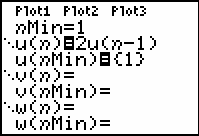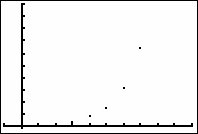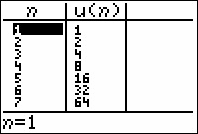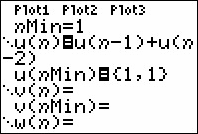This lesson investigates sequences that are defined recursively by examining the graph of the sequence and looking at the associated table of values.
Defining a Recursive Sequence
A recursive sequence defines a term an using one or more of the previous terms of the sequence. Because each term is defined using previous terms, the first few terms of the sequence must be defined explicitly.
Explore the recursive sequence shown below that defines each term of the sequence as twice the previous term, an = 2an - 1. The first term of the sequence is defined to be 1. The sequence may be written symbolically as two statements.
a1 = 1
an = 2an - 1, for n = 2, 3, 4, 5,...
Graphing the Recursive Sequence
Define the sequence in the Y= Editor.
-
Set u1(n) = 2 · u(n-1). Press

 to enter u.
to enter u.
The function notation u(n - 1) represents the function value at n - 1 and also represents the
The first term of the sequence must also be entered so that the calculator will have a value with which to evaluate the second term. Subsequent terms will be determined by using previously computed terms.
- Set nMin = 1.
- Set u(nMin) = 1.
- Set the window parameters to the values below.
- Display the graph of the sequence
u(nMin) represents u(1), the first term of the sequence.

| nMin = 1 | Xmin = -1 | Ymin = -1 |
| nMax = 10 | Xmax = 10 | Ymax = 100 |
| PlotStart = 1 | Xscl = 1 | Yscl = 10 |
| PlotStep = 1 |

The graph suggests that the sequence gets large without bound as n approaches infinity. If this is so, then the sequence diverges.
Creating a Table of Values
The divergence of the sequence can by supported by viewing a table of values.
-
Set TblStart = 1 and
 Tbl = 1 in the Table Setup dialog box.
Tbl = 1 in the Table Setup dialog box.
- Set Indpnt to "Auto."
- Display the Table.

It appears from the table that this sequence is the sequence an = 2n - 1. The sequence an = 2n - 1 is an example of a geometric sequence. This particular geometric sequence is in fact divergent.
Defining a Recursive Sequence Requiring Two Previous Values
In the sequence investigated above, each term was defined as twice the value of the preceding term. Recursive sequences can also be defined using more than one preceding term.
Explore the recursive sequence that defines each term as the sum of the two previous terms where a1 = a2 = 1 and an = an-1 + an-2 for n = 3, 4, 5,... .
- Return to the Y= editor.
- Set nMin = 1.
- Set u(n)=u(n-1)+u(n-2).
- Set u(nMin) = {1,1}.
The initial value u(nMin) is the list {1,1}, which represents the values of the first two terms. The symbols '{' and '}' are found above the parentheses keys.

-
Set TblStart = 1 and
 Tbl = 1.
Tbl = 1.
23.3.1 Display the table and, if possible, identify the sequence shown.
Click here for the answer.
Although sequences can be defined recursively using more than the previous two terms, the TI-83 is not able to do that.